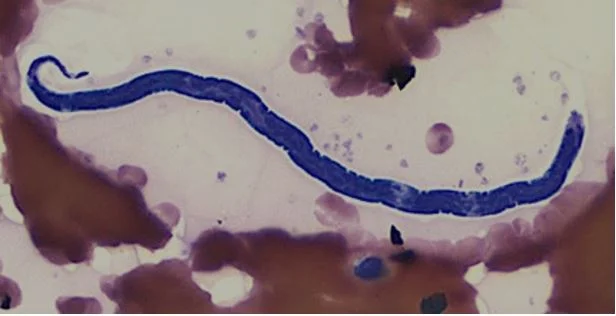Current Campaign
Loiasis
Loa loa filariasis is a skin and eye disease caused by the nematode worm Loa loa.
Loiasis, also known as African eye worm, is a disease caused by the parasitic worm Loa loa. Loiasis affects over 10 million people, predominantly in forested areas of West and Central Africa. The disease is transmitted to humans by day-biting flies and can lead to the presence of a 1–2 cm long adult worm under the skin or in the eye. The adult worms produce embryos, called microfilariae, which circulate in the blood stream during the day. In extreme cases, people can harbor over 50,000 microfilariae per milliliter of blood (about the volume of a thimble). Loiasis can be accompanied by transient swellings on the skin known as Calabar swellings, severe itching, joint pain, and fatigue. There is growing evidence that loiasis is associated with renal, cardiac, and neurological problems and with a shorter life expectancy.
Loa loa is not being addressed by any elimination programs and represents a major public health issue. Certain people with L. loa infections are at risk of brain inflammation (encephalopathy) when treated with ivermectin or diethylcarbamazine, two deworming drugs used in mass drug administration programs for the elimination of onchocerciasis and lymphatic filariasis. The encephalopathy can lead to coma and sometimes death. Treatment for loiasis exists but must be given by experienced medical doctors, especially in cases of high levels of microfilariae where incorrect chemotherapy is potentially lethal.
DDTD has developed a rapid diagnostic test designed for the high-resolution mapping of L. loa. The Loa Antibody Rapid Test is a Research Use Only (RUO) device. It is intended for epidemiology purposes and as a population surveillance tool. It is not used to establish a definitive diagnosis or as a basis to recommend a treatment to an individual person. This prototype is a model product specifically built for initial field-testing and to receive feedback from end-users in view of enhancing the design of future versions. The Loa Rapid Antibody Test only detects if a person has been exposed to L. loa in his or her lifetime; it cannot distinguish previous from current infections.
Overlap of loiasis (black-and-white pie charts) and onchocerciasis (color map). Loiasis was mapped with the Rapid Assessment Procedure for Loa (RAPLOA) where villagers are asked for a history of worms in the eyes in their village. The Rapid Epidemiological Mapping of Onchocerciasis (REMO) is done by monitoring the prevalence of nodules caused by subcutaneous “nests” of adult O. volvulus worms. Credit: We thank Dr. Zouré of the WHO for generating this map upon our request (November 2014).



